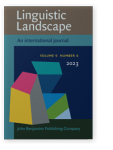Vol. 9:4 (2023) ► pp.329–356
Assessing the place of minoritized languages in postcolonial contexts using the Linguistic Landscape
The role of ethnographic information
Linguistic Landscape research has demonstrated that detailed analysis of written signage provides, often simultaneously, important insights into various aspects of the sociolinguistic dynamics of a context, particularly those involving minoritized languages. Comparatively little of that research has, however, focused on postcolonial contexts in which people make little use of literacy and in which locally widely used minoritized languages co-exist with an officially dominant ex-colonial language. This paper explores written signage involving minoritized languages in the town of Saint-Laurent-du-Maroni (French Guiana) and how it is shaped by local practices and social change. The paper argues that knowledge of the ethnographic context such as local practices of place belongingness, the place of writing, and processes of social change is indispensable when analyzing the Linguistic Landscape. When viewed from a holistic perspective, the Linguistic Landscape provides insights into local identities and the processes promoting them.
Article outline
- 1.Introduction
- 2.Social and historical background
- 2.1French Guiana
- 2.2Saint-Laurent-du-Maroni
- 2.3The sociolinguistic makeup of western French Guiana
- 2.4Maroon populations
- 3.Data and methodology
- 4.Non-French signage in SLM
- 4.1Health care domain
- 4.2Commercial domain
- 4.3.Official domain
- 4.4Summary
- 5.Conceptualizing and naming places among Maroons
- 5.1Constructing place in the up-river villages
- 5.2Early construction of place in SLM
- 5.3Contemporary repurposing practices
- 6.Some social changes
- 7.Summary and conclusion
- Acknowledgements
- Notes
-
References
For any use beyond this license, please contact the publisher at [email protected].
